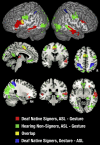Neural systems supporting linguistic structure, linguistic experience, and symbolic communication in sign language and gesture
- PMID: 26283352
- PMCID: PMC4577150
- DOI: 10.1073/pnas.1510527112
Neural systems supporting linguistic structure, linguistic experience, and symbolic communication in sign language and gesture
Abstract
Sign languages used by deaf communities around the world possess the same structural and organizational properties as spoken languages: In particular, they are richly expressive and also tightly grammatically constrained. They therefore offer the opportunity to investigate the extent to which the neural organization for language is modality independent, as well as to identify ways in which modality influences this organization. The fact that sign languages share the visual-manual modality with a nonlinguistic symbolic communicative system-gesture-further allows us to investigate where the boundaries lie between language and symbolic communication more generally. In the present study, we had three goals: to investigate the neural processing of linguistic structure in American Sign Language (using verbs of motion classifier constructions, which may lie at the boundary between language and gesture); to determine whether we could dissociate the brain systems involved in deriving meaning from symbolic communication (including both language and gesture) from those specifically engaged by linguistically structured content (sign language); and to assess whether sign language experience influences the neural systems used for understanding nonlinguistic gesture. The results demonstrated that even sign language constructions that appear on the surface to be similar to gesture are processed within the left-lateralized frontal-temporal network used for spoken languages-supporting claims that these constructions are linguistically structured. Moreover, although nonsigners engage regions involved in human action perception to process communicative, symbolic gestures, signers instead engage parts of the language-processing network-demonstrating an influence of experience on the perception of nonlinguistic stimuli.
Keywords: American Sign Language; brain; deafness; fMRI; neuroplasticity.
Conflict of interest statement
The authors declare no conflict of interest.
Figures







Similar articles
-
Comparing action gestures and classifier verbs of motion: evidence from Australian Sign Language, Taiwan Sign Language, and nonsigners' gestures without speech.J Deaf Stud Deaf Educ. 2005 Summer;10(3):272-90. doi: 10.1093/deafed/eni029. Epub 2005 Apr 27. J Deaf Stud Deaf Educ. 2005. PMID: 15858072
-
Dissociating linguistic and nonlinguistic gestural communication in the brain.Neuroimage. 2004 Aug;22(4):1605-18. doi: 10.1016/j.neuroimage.2004.03.015. Neuroimage. 2004. PMID: 15275917
-
Gestural communication in deaf children: the effects and noneffects of parental input on early language development.Monogr Soc Res Child Dev. 1984;49(3-4):1-151. Monogr Soc Res Child Dev. 1984. PMID: 6537463
-
Signed language and human action processing: evidence for functional constraints on the human mirror-neuron system.Ann N Y Acad Sci. 2008 Dec;1145:100-12. doi: 10.1196/annals.1416.023. Ann N Y Acad Sci. 2008. PMID: 19076392 Review.
-
Gesture, sign, and language: The coming of age of sign language and gesture studies.Behav Brain Sci. 2017 Jan;40:e46. doi: 10.1017/S0140525X15001247. Epub 2015 Oct 5. Behav Brain Sci. 2017. PMID: 26434499 Free PMC article. Review.
Cited by
-
Graph theoretical analysis of functional network for comprehension of sign language.Brain Res. 2017 Sep 15;1671:55-66. doi: 10.1016/j.brainres.2017.06.031. Epub 2017 Jul 6. Brain Res. 2017. PMID: 28690129 Free PMC article.
-
Sensitive periods in cortical specialization for language: insights from studies with Deaf and blind individuals.Curr Opin Behav Sci. 2020 Dec;36:169-176. doi: 10.1016/j.cobeha.2020.10.011. Epub 2020 Dec 1. Curr Opin Behav Sci. 2020. PMID: 33718533 Free PMC article.
-
Plasticity of the language system in children and adults.Handb Clin Neurol. 2022;184:397-414. doi: 10.1016/B978-0-12-819410-2.00021-7. Handb Clin Neurol. 2022. PMID: 35034751 Free PMC article. Review.
-
Reading words versus seeing font or handwriting style: a study of hemifield processing.Exp Brain Res. 2025 Jan 18;243(2):45. doi: 10.1007/s00221-024-06986-6. Exp Brain Res. 2025. PMID: 39825894
-
Psycholinguistic mechanisms of classifier processing in sign language.J Exp Psychol Learn Mem Cogn. 2021 Jun;47(6):998-1011. doi: 10.1037/xlm0000958. Epub 2020 Nov 19. J Exp Psychol Learn Mem Cogn. 2021. PMID: 33211523 Free PMC article.
References
-
- McNeill D. So you think gestures are nonverbal? Psychol Rev. 1985;92(3):350–371.
-
- Supalla T. 1982. Structure and acquisition of verbs of motion and location in American Sign Language. PhD thesis (University of California, San Diego)
-
- Liddell SK. Grammar, Gesture, and Meaning in American Sign Language. Cambridge Univ Press; Cambridge, UK: 2003.
-
- Emmorey K, et al. Neural systems underlying spatial language in American Sign Language. Neuroimage. 2002;17(2):812–824. - PubMed
Publication types
MeSH terms
Grants and funding
LinkOut - more resources
Full Text Sources
Other Literature Sources
Medical

